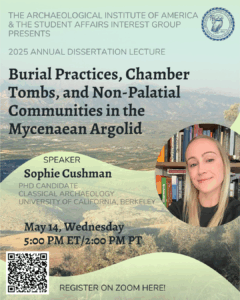
This is an online event.
Sponsored by: Student Affairs Interest Group
Please join the Student Affairs Interest Group for their annual Dissertation Lecture featuring Sophie Cushman, PhD candidate at the University of California, Berkeley, for her talk, “Burial Practices, Chamber Tombs, and Non-Palatial Communities in the Mycenaean Argolid” on Wednesday, May 14th at 5:00 PM ET/2:00 PM PT. The lecture will be held on Zoom – please register here.

Abstract:
With over 4,000 documented examples, rock-carved chamber tombs were by far the most common type of tomb in Late Bronze Age Greece (ca. 1600-1070 BCE). In the Argolid in particular, over 650 chamber tombs are known. However, previous interpretations of Mycenaean burial practices in this region have focused on the same, limited number of “wealthy” cemeteries and tombs, primarily located around the Argive plain. This talk instead considers Mycenaean burial practices from a bottom-up perspective based on a comprehensive study of all known cemeteries and tombs in the Argolid, tracing developments in chamber tomb use from the adoption of the type by select groups at the transition to the Late Bronze Age to the adaptation of existing burial practices in the second half of the period. First, I analyze the chronological and geographical distribution of chamber tomb cemeteries, proving that the type was adopted throughout the entire Argolid before the institutionalization of the palatial system. In fact, very few sites adopted chamber tombs for the first time during the palatial period. This conclusion challenges existing top-down narratives that see mortuary developments in the Argolid as imposed by or radiating out from the palatial centers of Mycenae and Tiryns. Next, I identify a change in secondary burial practices at the start of the palatial period. Drawing on a wide body of anthropological and archaeological theory, I argue that local burying groups actively adapted their mortuary behavior to emphasize local, kin-based claims to resources–both material and immaterial–in response to the increasing political and economic authority of the palace centers. I ultimately suggest that the chamber tomb took on new, and potentially subversive, meanings within the context of the palatial period. By shifting focus from wealthy tombs and the palace to the decision making processes of local burying groups, this project offers a fresh perspective on Mycenaean burial practices and social structure and contributes to our knowledge of those beyond the center of Mycenaean society.
About the speaker:
Sophie Cushman is a PhD candidate in Classical Archaeology at the University of California, Berkeley. Sophie specializes in Aegean prehistory, especially the second millennium BCE. Her research focuses on burial practices, sociopolitical organization, and pottery and material culture. An active field archaeologist, Sophie has excavated on Crete and throughout the Peloponnese. She is currently a senior staff member of the Nemea Center for Classical Archaeology’s excavation and publication projects at the Sanctuary of Zeus at Nemea, the multi-period cemetery of Aidonia, and Petsas House, Mycenae. Her dissertation offers the first comprehensive study of chamber tombs in the northeast Peloponnese, examining developments in burial practices from the perspective of small local communities as they responded to the increasing authority and subsequent collapse of regional centers during the Mycenaean period.
Notifications